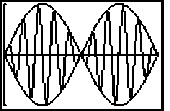Solve the problem.A product of two oscillations with different frequencies such as f(t) = sin(10t) sin(t)is important in acoustics. The result is an oscillation with "oscillating amplitude." the product f(t) of the two oscillations as a sum of two cosines and call it g(t).
the product f(t) of the two oscillations as a sum of two cosines and call it g(t). a graphing utility, graph the function g(t) on the interval 0 ? t ? 2?.
a graphing utility, graph the function g(t) on the interval 0 ? t ? 2?. the same system as your graph, graph y = sin t and y = -sin t.
the same system as your graph, graph y = sin t and y = -sin t.
src="https://sciemce.com/media/4/ppg__10624191808__f1q17g4.jpg" alt="" style="vertical-align: -4.0px;" /> last two functions constitute an "envelope" for the function g(t). For certain values of t, the two cosine functions in g(t) cancel each other out and near-silence occurs; between these values, the two functions combine in varying degrees. The phenomenon is known (and heard) as "beats." For what values of t do the functions cancel each other?
What will be an ideal response?
(i) g(t) =  cos(9t) -
cos(9t) -  cos(11t)
cos(11t)
(ii), (iii)

(iv) t =  , n any integer
, n any integer
Mathematics
src="https://sciemce.com/media/4/ppg__10624191808__f1q17g4.jpg" alt="" style="vertical-align: -4.0px;" /> last two functions constitute an "envelope" for the function g(t). For certain values of t, the two cosine functions in g(t) cancel each other out and near-silence occurs; between these values, the two functions combine in varying degrees. The phenomenon is known (and heard) as "beats." For what values of t do the functions cancel each other?
What will be an ideal response?
| (i) | g(t) =  cos(9t) - cos(9t) -  cos(11t) cos(11t) |

(iv) t =
 , n any integer
, n any integerYou might also like to view...
Find the derivative of the function.y = 
A. y ' = 
B. y ' = 
C. y ' = 
D. y ' = 
Add or subtract as indicated. -
- 
A.  w
w
B.  w2
w2
C.  w
w
D.  w2
w2
Use technology to calculate det A.A = 
A. -170.984 B. 136.96 C. 81.944 D. 831.136
Solve the problem.Jonathan estimated his GPA would be 3.08. When grades came out, he saw that his GPA was 3.01. Did he receive better grades than his estimate or worse?
A. Better B. Worse